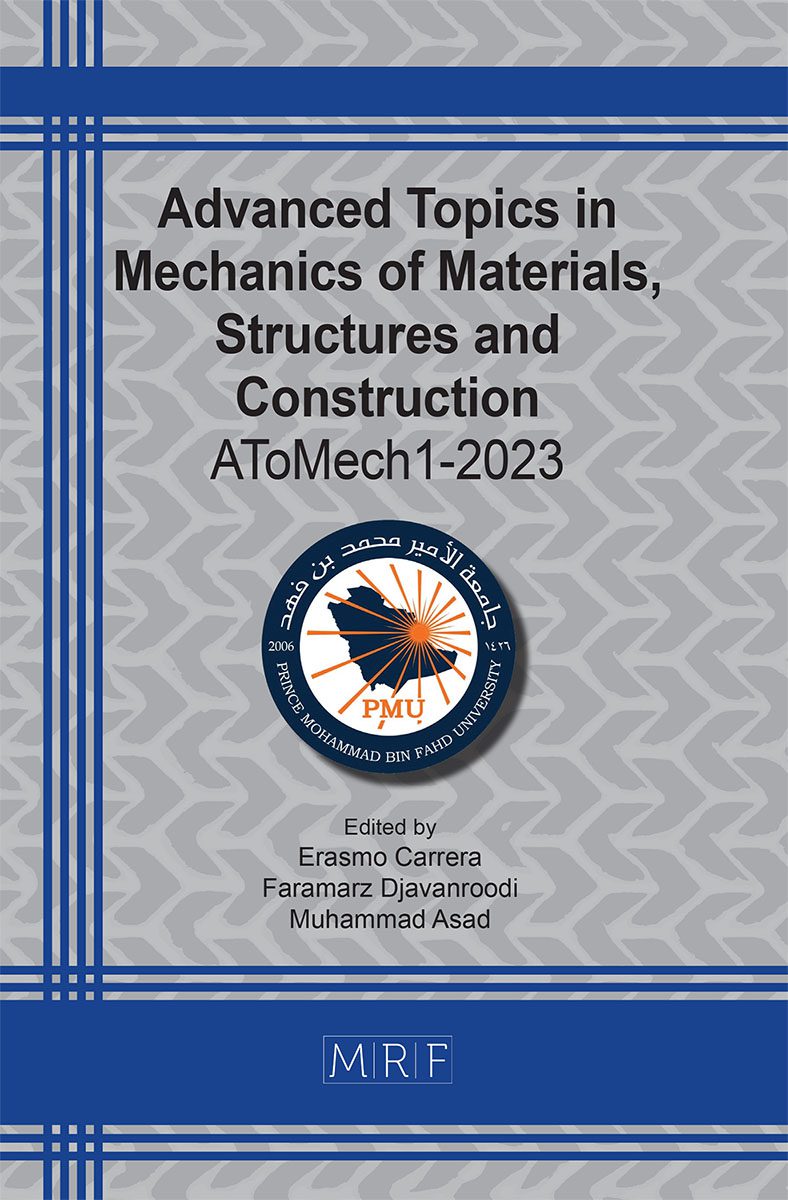New approach for modeling randomly distributed CNT reinforced polymer nanocomposite with van der Waals interactions
Umut Caliskan, Hilal Gulsen, Mustafa Kemal Apalak
download PDFAbstract. In this paper, using molecular and micromechanics methods, a new approach for the prediction of the stiffness of randomly distributed CNT/polymer nanocomposites with the van der walls interactions is presented. A multi-scale modeling technique was designed for CNT nanoparticles randomly embedded in the polymer using AMBER force field. This multi-scale model constitutes a representative volume element. The representative volume element consists of polymer, CNT nanoparticle, CNT-polymer interfacial region and van der waals bonds. A programming code was developed that randomly distributes nanoparticles according to the desired volume fraction. Python scripting language was used for the modeling technique performed in a finite element environment. By modeling the interfacial regions around randomly distributed CNTs, van der Waals bonds are modeled stochastically. In this study, the subject of interest is the number of CNTs positioned in the RVE according to the volume ratio. These numbers were determined at the level allowed by finite element equations and computational solvers and their effects were investigated by calculated stiffness behavior.
Keywords
Carbon Nanotube, Nanocomposite, Multi-Scale Model, Randomly Distribution, van der Waals Interactions
Published online 8/10/2023, 11 pages
Copyright © 2023 by the author(s)
Published under license by Materials Research Forum LLC., Millersville PA, USA
Citation: Umut Caliskan, Hilal Gulsen, Mustafa Kemal Apalak, New approach for modeling randomly distributed CNT reinforced polymer nanocomposite with van der Waals interactions, Materials Research Proceedings, Vol. 31, pp 55-65, 2023
DOI: https://doi.org/10.21741/9781644902592-7
The article was published as article 7 of the book Advanced Topics in Mechanics of Materials, Structures and Construction
![]() Content from this work may be used under the terms of the Creative Commons Attribution 3.0 license. Any further distribution of this work must maintain attribution to the author(s) and the title of the work, journal citation and DOI.
Content from this work may be used under the terms of the Creative Commons Attribution 3.0 license. Any further distribution of this work must maintain attribution to the author(s) and the title of the work, journal citation and DOI.
References
[1] A. Hussein, B. Kim, Micromechanics based FEM study on the mechanical properties and damage of epoxy reinforced with graphene based nanoplatelets, Composite Structures, 215 (2019), 266-277. https://doi.org/10.1016/j.compstruct.2019.02.059
[2] S. Iijima, Helical microtubules of graphitic carbon. Nature, 354 (1991), 56-8. https://doi.org/10.1038/354056a0
[3] D. Qian, G. J. Wagner, W. K. Liu, M. F. Yu, R. S. Ruoff, Mechanics of carbon nanotubes, Applied Mechanics Reviews, 55(2022), 495-533. https://doi.org/10.1115/1.1490129
[4] D. Qian, E. Dickey, R. Andrews, T. Rantell, Load transfer and deformation mechanisms in carbon nanotube-polystyrene composites, Appl Phys Lett, 76(2000), 2868-70. https://doi.org/10.1063/1.126500
[5] K.I. Tserpes, P. Papanikos, G. Labeas, and Sp.G. Pantelakis, Multi-scale modeling of tensile behavior of carbon nanotube-reinforced composites, Theoretical and Applied Fracture Mechanics, 49(2008), 51-60. https://doi.org/10.1016/j.tafmec.2007.10.004
[6] S.M.R. Khalili and A. Haghbin, Multi-scale modeling of nonlinear tensile behavior in single-walled carbon nanotube reinforced nanocomposites, International Journal of Modeling and Optimization,1(2011), 199-204. https://doi.org/10.7763/IJMO.2011.V1.35
[7] M.R. Ayatollahi, S. Shadlou and M.M. Shokrieh, Multiscale modeling for mechanical properties of carbon nanotube reinforced nanocomposites subjected to different types of loading, Composite Structures, 93(2011), 2250-2259. https://doi.org/10.1016/j.compstruct.2011.03.013
[8] G.M. Odegard, T.S. Gates, K.E. Wise, C. Park, E.J. Siochi, Constitutive Modeling of Nanotube-Reinforced Polymer Composites, Composites Science and Technology, 63 (2003), 671-1687. https://doi.org/10.1016/S0266-3538(03)00063-0
[9] ABAQUS/Standart, User’s manual, Finite Element Software. www.simulia.com
[10] S.M.R. Khalili and A. Haghbin, Investigation on design parameters of single-walled carbon nanotube reinforced nanocomposites under impact loads, Composite Structures, 98(2013), 253-260. https://doi.org/10.1016/j.compstruct.2012.09.049
[11] L. Battezzati, C. Pisani, F. Ricca, Equilibrium conformation and surface motion of hydrocarbon molecules physisorbed on graphite J. Chem. Soc., Faraday Trans. 2: Mol. Chem. Phys., 71 (1975), 1629-1639. https://doi.org/10.1039/f29757101629
[12] Z. Shokrieh, M.M. Shokrieh, A new model to simulate the creep behavior of graphene/epoxy nanocomposites, Polymer Testing, 75 (2019), 321-326. https://doi.org/10.1016/j.polymertesting.2019.02.032
[13] Shokrieh, M., M., Rafiee, R. Investigation of nanotube length effect on the reinforcement efficiency in carbon nanotube based composites, Composite Structures, 92 (2010) (10), 2415-2420. https://doi.org/10.1016/j.compstruct.2010.02.018































